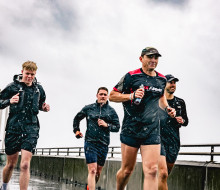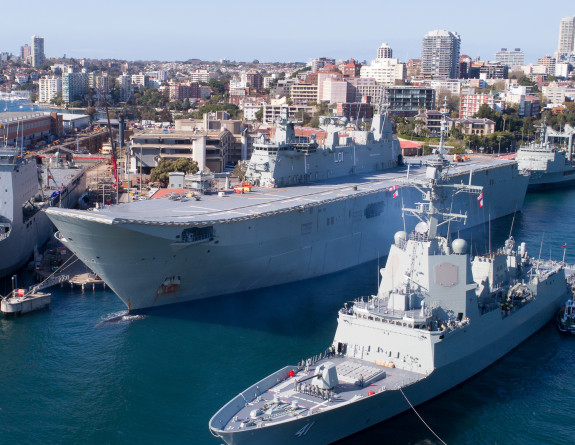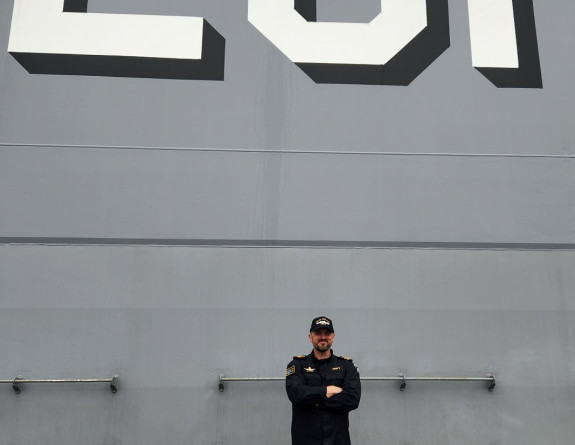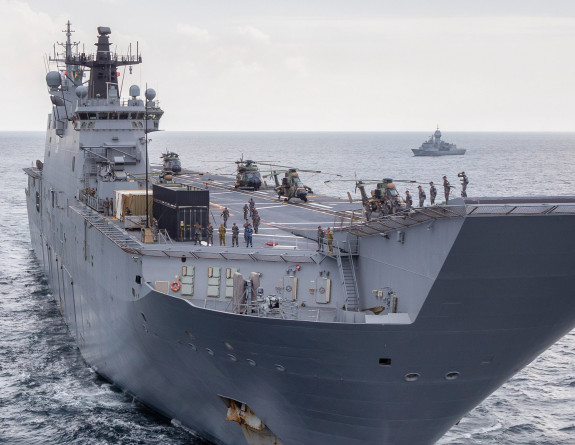
Hawke's Bay Reserve Force soldier tackles world's toughest race for charity
15 April 2024
Unfortunately you are viewing this website on an outdated browser which does not support the necessary features for us to provide an adequate experience. Please switch to a modern browser such as latest version of Google Chrome, Mozilla Firefox, Apple Safari or Microsoft Edge.
Ngā mihi nui
Lieutenant Commander Jerry Kemp, Royal New Zealand Navy, says he feels very blessed to practise his trade aboard the Royal Australian Navy’s largest and senior ship.
LTCDR Kemp is the Navigating Officer of the 231-metre Landing Helicopter Dock ship HMAS Adelaide, after completing the year-long Principal Warfare Officer training at Australia’s maritime warfare and navigation training establishment HMAS Watson in Sydney. He was awarded dux of the Advanced Navigation course and is now posted to Adelaide until December 2025.
Royal New Zealand Navy warfare officers undergo Officer of the Watch and Bridge Warfare Officer courses in New Zealand, and will then join classes in the United Kingdom or Australia for their Principal Warfare Officer’s course. A posting to a Royal Navy or Royal Australian Navy ship often follows to consolidate the training.
Originally from South Africa, LTCDR Kemp moved to New Zealand in 2002, first to Wairarapa and then Auckland’s King’s College as a boarder. He joined the Navy in 2005 as a Seaman Combat Specialist, leaving in 2007 to start university studies. He rejoined as an officer in 2010 and completed his studies under a Navy scholarship scheme, then graduated from officer training as a Supply Officer. In 2016 he changed trades to Warfare Officer.
“I was attracted to the Navy because I wanted to follow in my grandfather’s footsteps and become a Navy diver. Unfortunately, I could not equalise adequately and found myself along numerous other pathways in Defence until I found my calling as a Navigator.”
You would think that on a ship as large as Adelaide that there would be more than one navigator or maybe a deputy navigator but that isn’t the case. It’s just him.
“I’m lucky, though, I’m part of a very big team. Our bridge structure and routine is like any other warship. There is myself as the Navigating Officer, the Officer of the Watch which may include an assistant, a Quartermaster and a Bosun’s mate. We have a proud methodology in Adelaide of focusing on training, and we support the training establishments ashore and take on trainees wherever possible. The last time we went to sea, we had an extra 27 Officers of the Watch to try and provide sea-going experience and assist them in gaining a platform endorsement.
“We all need to work closely together to ensure the ship is able to achieve all the tasking set for it over the year. It could range from mess dinners alongside, catering for 400 people, or conducting amphibious landings on a beach with multiple landing craft and a range of helicopters utilised on board.”
They have a busy year ahead. “We’ll be proving a range of capabilities and supporting Australian Army and Royal Australian Air Force fleet training. We will then shift focus and prepare to deploy overseas to reinforce Australia’s commitment to a peaceful, secure and prosperous region.”
As Navigator he’s got some challenges coming up.
“Adelaide is often referenced as a 50-story apartment block on its side, capable of launching four landing craft and eight helicopters near simultaneously.”



LTCDR Kemp is the Navigating Officer of the 231-metre Landing Helicopter Dock ship HMAS Adelaide
He enjoys the camaraderie on board Adelaide.
“Adelaide really has a great crew, very welcoming and supportive. Everyone wants to do their best and as the senior ship of the Royal Australian Navy we all do our best to lead by example to ensure excellence but to also make sure we are available to the rest of the fleet to guide, mentor and assist where ever we can.”
The Australians operate very similarly to New Zealand. “It’s great we can achieve an almost seamless transition from one platform to another. I love working with the Aussies. Not only are they a world-class Navy but they are also experiencing some major changes and enhancements to their capability in support of their Australian Defence Strategic Review. It’s an exciting time to be here.
“Like us, they are experiencing challenges in retention and recruitment and like us, they are a bunch of very capable individuals, trying to do their very best every day in support of the Australian Defence Force and protecting their national interests.”
There is one quirk he’s noticed. “One that always gets me is not only do they have more acronyms than we do, but they do this funny thing where they don’t say the letters of the acronym but instead turn the acronym into a word.”
His advice to someone looking at a Navy career boils down to three things, he says.
“You will be pushed hard to be the best version of yourself. This will take time, patience and hard work is essential.
“Every two to three years you can post in to a range of vastly different opportunities ranging from watchkeeping at sea, to being part of the Capability Branch or posting on Operation anywhere in the world. This also means, when you get a posting you don’t like, or a boss you don’t get along with, very soon you may be on the next posting and doing the most exciting thing you have ever experienced.
“And, when you’re sitting with your civilian mates at a dinner table, can they say that today they hunted a submarine, coordinated aircraft to a target, berthed a warship in a foreign port, or conducted amphibious operations? Can they say that every day that they turn up to work they make a positive difference to New Zealand’s interests?”